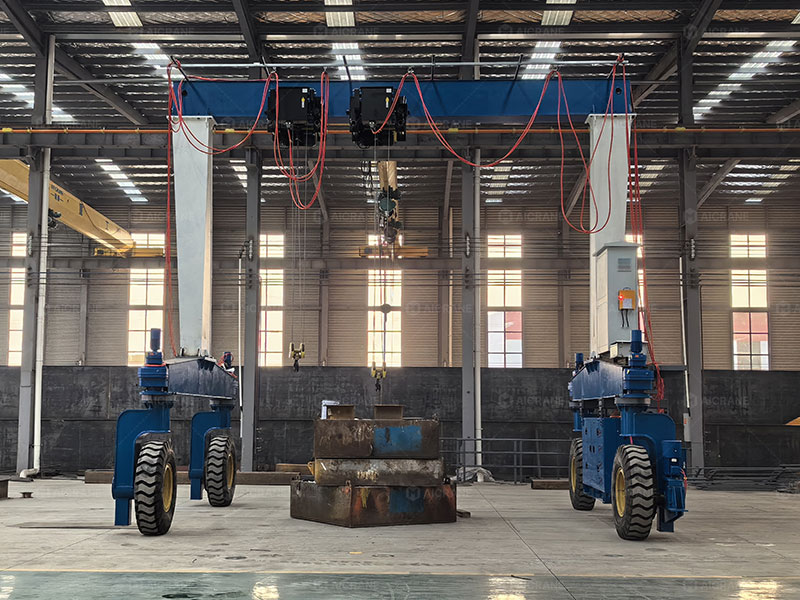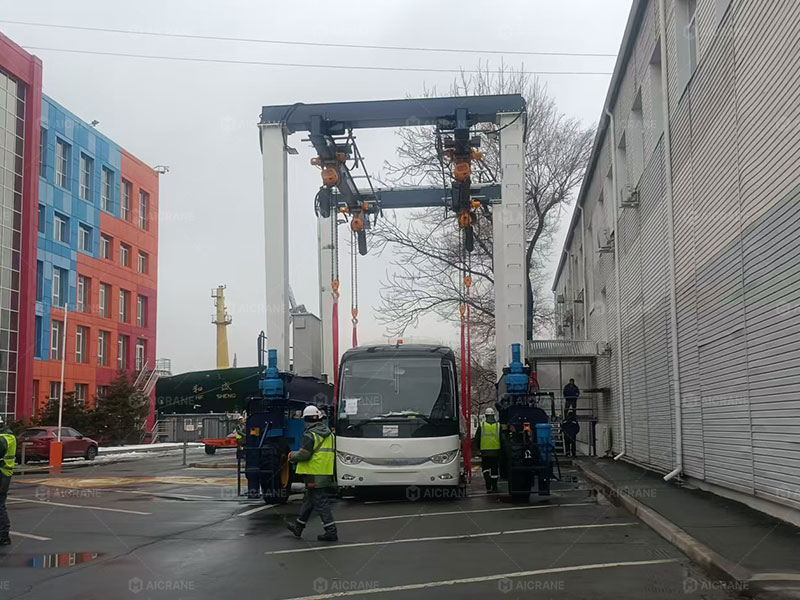In industries that require frequent movement of heavy loads across different job sites – such as construction, shipbuilding, logistics, and manufacturing—the mobile 25-ton gantry crane has emerged as an ideal lifting solution. Its design combines substantial lifting power with mobility, making it a practical choice for operations that demand flexibility, efficiency, and safety. This article explores the key aspects of mobile 25-ton gantry crane design, focusing on structural features, mobility systems, control options, safety measures, and customization to meet diverse on-site requirements.

1. Overview of Mobile 25 Ton Gantry Cranes
A mobile 25 ton gantry crane is a versatile material handling system designed to lift and move loads up to 25 tons within a worksite or between different work areas. Unlike fixed gantry cranes that are anchored to rails, mobile gantry cranes are typically rubber-tyred or trackless, allowing them to move freely over flat surfaces. Their design is particularly valuable in temporary construction zones, outdoor yards, and industrial facilities where installation of permanent crane structures is not feasible.
The 25-ton capacity represents a balance between heavy-duty lifting performance and ease of movement. It is sufficient for handling precast concrete elements, steel beams, containers, and other bulky loads, while remaining mobile enough to navigate within constrained environments.
2. Structural Design and Frame Composition
The structure of a mobile 25-ton gantry crane is engineered to provide both strength and mobility. The main components typically include:
-
Main Beam: The upper girder that carries the hoist and trolley, designed for high load-bearing capacity and minimal deflection. Depending on the span and duty class, the girder may be a single box-type or double girder design.
-
Leg Frames: Supporting legs made from high-strength steel, connected to the traveling mechanism. They are reinforced with cross bracing to enhance rigidity and stability during lifting operations.
-
End Carriages: Fitted with wheel assemblies or steerable axles that enable mobility and turning functions.
-
Base Structure: The chassis or bogie system supports the crane’s weight distribution and mobility under load.
For mobile designs, structural weight optimization is crucial. Engineers often use finite element analysis (FEA) to minimize stress concentrations and ensure stability during travel. This allows the mobile gantry crane to maintain its structural integrity while being light enough for movement across different terrains.
3. Mobility and Steering Systems
Mobility is the defining characteristic of this crane type. The 25-ton mobile gantry crane typically features rubber-tyred wheels, providing smooth movement on concrete or asphalt surfaces without the need for rails. Some advanced designs include multi-mode steering systems such as:
-
Straight Steering: For linear movement along a fixed path.
-
Crab Steering: Enables diagonal motion for precise positioning.
-
Pivot Steering: Allows the crane to rotate around a central point for confined spaces.
-
Independent Wheel Steering: Enhances maneuverability on uneven or restricted job sites.
These steering systems are powered by hydraulic or electric drive units, controlled via remote or cabin interface. The ability to move in multiple directions makes the mobile 25-ton gantry crane ideal for dynamic lifting operations, such as repositioning heavy materials within large construction areas or ports.
4. Hoisting and Trolley Mechanism Design
The hoisting mechanism is the core of the overhead gantry crane lifting performance. In a 25-ton configuration, it often employs an electric wire rope hoist or electric chain hoist, depending on lifting height and speed requirements. The hoist is mounted on a trolley that travels horizontally along the main beam, providing flexibility in load placement.
Key design considerations include:
-
Hoisting Speed: Optimized for efficient lifting while maintaining load stability. Variable frequency drives (VFDs) are often integrated to allow smooth acceleration and deceleration.
-
Lifting Height: Customized to site requirements, generally between 6–12 meters for most applications.
-
Trolley Travel: Equipped with frequency-controlled motors for precise positioning.
-
Load Control: Modern designs incorporate anti-sway systems and load sensors to ensure safety and balance during operation.
The combination of these features ensures smooth, controlled motion even when lifting the maximum 25-ton load.

5. Power Supply and Control Systems
Mobile gantry cranes typically utilize battery-powered or diesel-electric hybrid systems for energy supply. The choice depends on application needs and environmental conditions.
-
Battery Power: Ideal for indoor or environmentally sensitive operations. Offers zero emissions and quiet operation.
-
Diesel-Electric Hybrid: Provides extended operation time and high power output for outdoor or remote sites.
Control systems are designed for ease of operation and safety. Common configurations include:
-
Wireless Remote Control: Allows operators to control crane movements from a safe distance.
-
Cabin Control: Provides better visibility for complex lifting tasks.
-
Dual Control Mode: Combines both systems for operational flexibility.
Advanced systems integrate PLC control and VFD technology, improving synchronization and reducing mechanical stress. These intelligent controls enable precise motion, energy efficiency, and fault detection for preventive maintenance.
6. Safety Features and Stability Design
Safety is a critical aspect of any gantry crane design. A 25-ton mobile unit must maintain stability under load and during movement. Design elements include:
-
Load Limiters: Prevent overloading beyond rated capacity.
-
Emergency Stop Systems: Instantly halt crane movement in unsafe conditions.
-
Windproof Brakes and Outriggers: Provide additional stability in outdoor operations.
-
Collision Avoidance Sensors: Detect obstacles during travel.
-
Tire Pressure Monitoring Systems (TPMS): Ensure balanced support across all wheels.
Moreover, structural safety is verified through rigorous load testing and deflection analysis. Compliance with international standards such as ISO, FEM, and CMAA ensures that the crane meets global safety and performance requirements.
7. Customization for On-Site Flexibility
The true advantage of a 25-ton rubber tyre gantry crane lies in its customizability. Depending on the customer’s operational environment, the crane can be configured with:
-
Adjustable Height and Span: Hydraulic or mechanical systems to modify clearance for different loads.
-
Detachable Structure: Modular design allows easy assembly and disassembly for transport between job sites.
-
Weatherproof Protection: Coating systems for corrosion resistance in coastal or outdoor use.
-
Specialized Attachments: Spreaders, C-hooks, or lifting beams for specific materials like precast beams, steel coils, or containers.
Such design flexibility allows the crane to adapt to various industrial tasks – ranging from handling construction components to moving heavy equipment in maintenance yards.
8. Applications and Benefits
Mobile 25-ton gantry cranes are widely used in:
-
Construction Sites: For lifting concrete panels, beams, and formwork.
-
Manufacturing Facilities: For relocating heavy machinery or molds.
-
Shipyards and Ports: For cargo handling and equipment assembly.
-
Warehouses and Workshops: For flexible material movement without fixed rails.
The main benefits include:
-
High Mobility: Easy repositioning reduces downtime.
-
Cost Efficiency: No permanent foundation or rail installation required.
-
Operational Flexibility: Can serve multiple locations or projects.
-
Quick Setup: Modular assembly enables fast deployment.
9. Future Trends in Mobile Gantry Crane Design
As technology advances, mobile gantry crane design continues to evolve toward automation, energy efficiency, and digitalization. Future trends include:
-
Integration with IoT Sensors for real-time monitoring of load conditions and system health.
-
Autonomous Steering and Path Navigation for unmanned operation.
-
Hybrid and Fully Electric Power Systems for sustainable, emission-free operation.
-
Digital Twin Simulation for pre-deployment design validation and predictive maintenance.
These innovations will further enhance the efficiency, safety, and adaptability of 25-ton mobile gantry cranes for next-generation industrial applications.
Conclusion
The mobile 25-ton gantry crane embodies the perfect blend of strength, versatility, and flexibility. Its innovative design allows it to meet the evolving demands of on-site lifting operations, from construction and logistics to shipbuilding and manufacturing. Through structural optimization, intelligent control, and safety-focused engineering, this crane type provides a cost-effective and efficient lifting solution for modern industries. As automation and smart technologies continue to advance, the future of mobile gantry crane design promises even greater operational freedom and efficiency across diverse industrial environments.